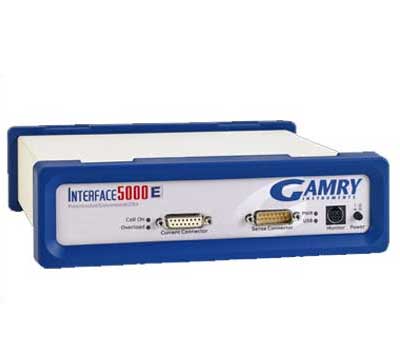Interface 5000E TM is an electrochemical test system for battery testing. It can be applied to the testing of fuel cells or supercapacitor energy devices.
电化学工作站
系统特点:
Interface 5000E
The Interface 5000E is an electrochemical test system designed for single-cell battery testing or any other energy device. It can perform a series of electrochemical tests such as voltage and impedance of two half cells and full cells.
double potentiometer
The dual potentiometer design enables simultaneous electrochemical measurements of two half-cells in a typical three-electrode system design. In charge-discharge and impedance measurements, simultaneous electrochemical characterization of the entire cell, as well as anode and cathode, can be achieved.

(Click image to Enlarge)
Impedance Spectrum Accuracy Contour Plot
Impedance-accurate spectra give the performance of the instrument. The spectra include the effects of instrument leads. The importance of accurate impedance spectroscopy is that it can be used to compare impedance measurement performance from different manufacturers, ensuring that researchers have the measurements they need.

Multi-Channel
Potentiostat The Interface 5000E can be configured as a single-channel potentiostat, dual potentiostat, or multi-channel potentiostat, providing researchers with greater flexibility.
更多细节
Below are more features about the Interface 5000E Electrochemical Workstation.
-
Electrochemical energy - test single cell or stack, fuel cell or super capacitor charge, discharge, cycle charge and discharge, constant potential, constant current, self-discharge, leakage current, read battery voltage, etc.
-
Electrochemical Impedance Spectroscopy - including potentiostatic, galvanostatic and hybrid impedance spectroscopy experiments with Mott-Schottky experimental techniques at single point frequencies. Adopt unique power leveling multisine technology to improve signal-to-noise ratio. In terms of analysis, there are equivalent circuit model analysis data software, Kramers-Kronig transform data verification data reliability and impedance graphical model editor. .
-
Physical Electrochemistry - Cyclic Voltammetry, Chronoamperometry, and Chronopotentiometry and related techniques derived from these measurements.
-
Pulse Voltammetry - Pulse voltammetry, square wave voltammetry, and related techniques such as anodic stripping voltammetry.
-
DC Corrosion - Run standard DC corrosion tests such as polarization resistance, potential, cyclic polarization and galvanic corrosion, etc.
-
Electrochemical Signal Analyzer - Software for acquisition and analysis of time-correlated electrochemical noise signals. Continuous monitoring of voltage and current at rates from 0.1 Hz to 1 kHz. Full-featured analysis tools such as statistical analysis, trend, impedance spectroscopy, and histogram analysis.
-
Electrochemical Frequency Modulation - A Nondestructive Corrosion Rate Measurement Method. With this technique, the corrosion rate is directly measured without Tafel's constant. In addition, the technique can determine the Tafel constant and provide parameters related to pitting.
-
Critical Pitting Temperature - Controls the Gamry potentiostat, TDC4 temperature controller, and related accessories to automatically measure the critical pitting temperature of materials.
-
Electrochemical Noise - Electrochemical noise testing is a more general technique. It is compatible with the ECM8 multiplexer software package for electrochemical noise measurements.
-
eChemAC Toolkit - Software toolkit for full control of potentiostats for impedance (EIS) measurements and EFM experiments.
other details
- 2, 3, 4 and 5 electrode measurements
- Measure both half-cell voltage and full-cell voltage
- Electrical isolation
- Floating: For autoclaves, mechanically stressed equipment or pipelines. stress apparatus, or pipeline probes.
- portable
- The size of a chemistry textbook and weighs only 3kg. USB 2.0 connection to Windows computer.
- Built-in EIS
- EIS measurements from 10 μHz to 1 M Hz were performed using an advanced DDS.
- DSP (Digital Signal Processing) Mode
- Oversampling mode improves signal-to-noise ratio and accurate capacitance measurements.
-
Current Interruption IR Compensation
- The Gamry potentiostat and its control software use linear regression to accurately measure and achieve IR compensation.
- Auxiliary I/O
- Control third-party equipment through I/O design: realize external signal input, analog voltage output, analog current output, auxiliary
A/D input and digital I/O connector. - RTD temperature probe measurement
- Control third-party equipment through I/O design: realize external signal input, analog voltage output, analog current output, auxiliary
- hedging period
- 2 year factory warranty.
下栽
Interface 5000E Part #992-00100 / #992-100
参数与
system |
|
| Electrode connection | 2, 3, 4 or 5 electrodes |
| High Current | ±5 A |
| Current range | 6 (50 μA - 5 A) |
| Current range (including internal gain) | 8 |
| Small current resolution | 15 pA |
| Large applied potential | ± 6 V |
| Rise Time | <1 μs |
| Small time base | 10 μs |
| Noise and ripple (typical) | <20 μV rms |
Control amplifier |
|
| Trough pressure | ± 8.5 / ± 2.5 V |
| High Current | >±5 A |
| Speed setting | 5 |
| Gain bandwidth (typical) | 1050, 250, 43, 4.4, 0.5 kHz |
EIS measurement |
|
| Frequency Range | 10 μHz - 1 MHz |
| EIS accuracy | See Accuracy Contour Plot |
| Applied voltage amplitude | 3 V maximum |
| Applied current amplitude | 5 The maximum |
Potentiometer |
|
| input resistance | >1012 Ω || <2 pF |
| Input Current | <25 pA |
| Bandwidth (-3 dB) (typical) | >12 MHz at -3 dB |
| Common mode rejection ratio | >98 dB (10 kHz) >88dB (100 kHz) |
Potential |
|
| Application accuracy | ±1 mV ±0.2% setting range |
| Applied resolution | 200 μV, 50 μV, 12.5 μV/bit |
| measurement accuracy | ±0.5 mV ±0.2% of reading range |
| Measurement resolution | 200 μV, 20 μV, 2 μV/bit |
Current |
|
| Application/measurement accuracy | ±25 pA ±0.05% of range ±0.2% of value |
| Application/measurement resolution | 0.0033% full-scale/bit |
| bandwidth | >5 MHz (5 mA) |





